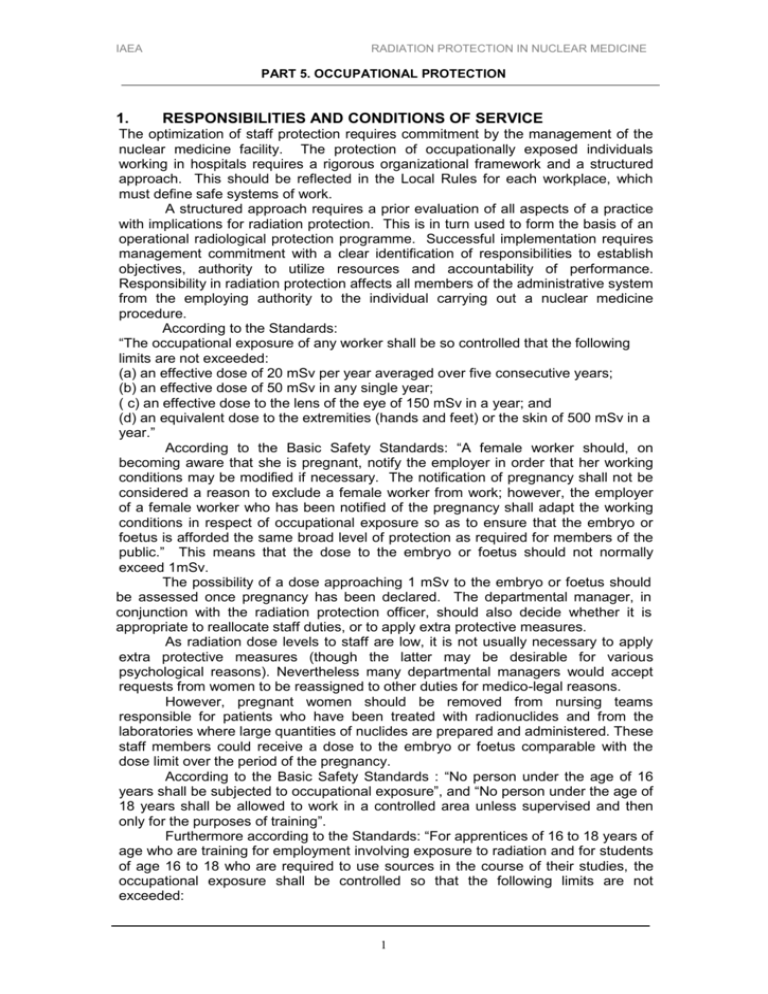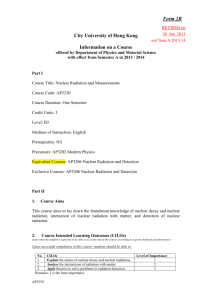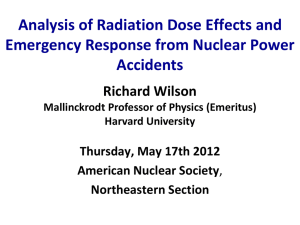Radiation protection in Nuclear Medicine
advertisement

IAEA RADIATION PROTECTION IN NUCLEAR MEDICINE PART 5. OCCUPATIONAL PROTECTION 1. RESPONSIBILITIES AND CONDITIONS OF SERVICE The optimization of staff protection requires commitment by the management of the nuclear medicine facility. The protection of occupationally exposed individuals working in hospitals requires a rigorous organizational framework and a structured approach. This should be reflected in the Local Rules for each workplace, which must define safe systems of work. A structured approach requires a prior evaluation of all aspects of a practice with implications for radiation protection. This is in turn used to form the basis of an operational radiological protection programme. Successful implementation requires management commitment with a clear identification of responsibilities to establish objectives, authority to utilize resources and accountability of performance. Responsibility in radiation protection affects all members of the administrative system from the employing authority to the individual carrying out a nuclear medicine procedure. According to the Standards: “The occupational exposure of any worker shall be so controlled that the following limits are not exceeded: (a) an effective dose of 20 mSv per year averaged over five consecutive years; (b) an effective dose of 50 mSv in any single year; ( c) an effective dose to the lens of the eye of 150 mSv in a year; and (d) an equivalent dose to the extremities (hands and feet) or the skin of 500 mSv in a year.” According to the Basic Safety Standards: “A female worker should, on becoming aware that she is pregnant, notify the employer in order that her working conditions may be modified if necessary. The notification of pregnancy shall not be considered a reason to exclude a female worker from work; however, the employer of a female worker who has been notified of the pregnancy shall adapt the working conditions in respect of occupational exposure so as to ensure that the embryo or foetus is afforded the same broad level of protection as required for members of the public.” This means that the dose to the embryo or foetus should not normally exceed 1mSv. The possibility of a dose approaching 1 mSv to the embryo or foetus should be assessed once pregnancy has been declared. The departmental manager, in conjunction with the radiation protection officer, should also decide whether it is appropriate to reallocate staff duties, or to apply extra protective measures. As radiation dose levels to staff are low, it is not usually necessary to apply extra protective measures (though the latter may be desirable for various psychological reasons). Nevertheless many departmental managers would accept requests from women to be reassigned to other duties for medico-legal reasons. However, pregnant women should be removed from nursing teams responsible for patients who have been treated with radionuclides and from the laboratories where large quantities of nuclides are prepared and administered. These staff members could receive a dose to the embryo or foetus comparable with the dose limit over the period of the pregnancy. According to the Basic Safety Standards : “No person under the age of 16 years shall be subjected to occupational exposure”, and “No person under the age of 18 years shall be allowed to work in a controlled area unless supervised and then only for the purposes of training”. Furthermore according to the Standards: “For apprentices of 16 to 18 years of age who are training for employment involving exposure to radiation and for students of age 16 to 18 who are required to use sources in the course of their studies, the occupational exposure shall be controlled so that the following limits are not exceeded: 1 IAEA RADIATION PROTECTION IN NUCLEAR MEDICINE PART 5. OCCUPATIONAL PROTECTION (a) an effective dose of 6 mSv in a year; (b) an equivalent dose to the lens of the eye of 50 mSv in a year; and (c) an equivalent dose to the extremities or the skin of 150 mSv in a year.” When working in a nuclear medicine facility students and trainees should always be accompanied by an authorized teacher. 2. CLASSIFICATION OF AREAS Areas in a nuclear medicine department are generally classified as controlled or supervised (BSS I.21–25). The rooms for preparation, storage and injection of the radiopharmaceuticals shall be controlled areas. Due to the potential risk of contamination, the imaging rooms and waiting areas should also be controlled areas. The area housing a patient to whom therapeutic amounts of activity have been given shall also be a controlled area. In the case of pure beta emitters such as Y-90, Sr-89 or P-32, which are not excreted from the body, the area may not need to be classified as a controlled area. The room for temporary storage of radioactive waste shall be a controlled area. It might be convenient to classify the whole nuclear department as a supervised area mainly due to the risk of contamination. Each room of the facility should only be used for its specified work. On the basis of a safety assessment including the planned use of each area, an evaluation of shielding and the potential for contamination, the licensee should determine whether an area where unsealed sources are handled or stored will be maintained as a controlled, supervised or uncontrolled area. The licensee should also assess which other areas (e.g. other patient rooms, stairwells, nursing stations, waiting areas, toilets) should be controlled, supervised or uncontrolled areas. The radiation dose-rate levels associated with these areas must be in compliance with the dose limits established by the Regulatory Authority. 3. SOURCES OF EXPOSURE Exposure of the worker may arise from unsealed sources either through external irradiation of the body or through entry of radioactive substances into the body. The main precautions required in dealing with external irradiation depend on the physical characteristics of the emitted radiation, the activity and the half-life of the radionuclide. When a radionuclide enters the body, the internal exposure will depend on factors such as the physical and chemical properties of the radionuclide, the activity and the biokinetics. Every type of work performed in a nuclear medicine department will make a contribution to the external exposure of the worker: unpacking radioactive material, activity measurements, storage of sources, preparation of radiopharmaceuticals, administration of radiopharmaceuticals, patient examination, care of the radioactive patient and handling of radioactive waste. The highest doses will generally be received during the patient examination. Higher risk of internal exposure due to contamination is associated with radioactive spills, animal experiments, emergency surgery of a therapy patient, and autopsy of a therapy patient. 4. PERSONAL PROTECTIVE EQUIPMENT AND SAFE HANDLING OF SOURCES Protective clothing should always be used in working areas where there is a likelihood of contamination. It may include laboratory coats or protective gowns; waterproof gloves of high quality; overshoes and, if required by the National Authorities, special clothing for aseptic work. 2 IAEA RADIATION PROTECTION IN NUCLEAR MEDICINE PART 5. OCCUPATIONAL PROTECTION Laboratories used for work with unsealed sources should be provided with equipment to minimize the external exposure of the worker and to deal with radioactive spill. This equipment may need to include: Tools for remote handling of sources (forceps, tongs) Shielded containers for the radionuclides in use Syringe shields Lead barrier with lead glass window Area monitor with alarm Contamination monitor Carrying containers for moving radionuclides Equipment and materials to deal with spills (emergency kit) Movable shields or the use of a lead apron should be considered during patient examinations and in the care of patients undergoing therapy with unsealed sources. Working procedures should be designed to prevent contamination and spread of contamination from the working areas. This will normally be achieved by a proper use of the personal protective equipment, by adopting clean operating conditions and good laboratory practice. The worker should be trained to deal with radioactive spills and decontamination procedures (surfaces, equipment, persons). 5. MONITORING Individual dose monitoring shall be undertaken for workers who are normally exposed to radiation in controlled areas (BSS I.32–36). These workers include nuclear medicine physicians, nuclear medicine physicists, nuclear medicine technologists, nuclear medicine nurses and radiopharmacists. Other users of radioisotope sources, such as clinical specialists, research staff and ancillary workers who frequently work in controlled areas, should also be individually monitored. Individual external doses shall be determined by using individual monitoring devices approved by the Regulatory Authority, such as thermoluminescent dosimeters, film badges or other devices. The individual monitoring device should be typically worn on the front of the upper torso because, in nuclear medicine, the whole body is assumed to be fairly uniformly exposed. When there is a possibility of high exposure to the hands, such as in the preparation and administration of radiopharmaceuticals, extremity dosimeters should be worn (if compatible with good clinical practice). The exchange of dosimeters and receipt of the dose reports shall be for the period specified by the Regulatory Authority. Because evaluation of dosage is an essential part of the radiation protection programme, it is important that workers return dosimeters on time for processing. Delays in the evaluation of a dosimeter can result in the loss of the stored information. Licensees should make every effort to recover any missing dosimeters. If an individual’s dosimeter is lost, the RPO should perform and document an evaluation of the dose the individual received and add it to the worker’s dose record. This can be done using the workers recent dose-history, doses of co-worker or the results of workplace monitoring. In nuclear medicine, the exposure due to internal contamination shall be monitored. It should be done by external monitoring of the thyroid for individuals handling large activities of radioiodine. Note that a gamma camera with no collimator mounted can be used as a whole body counter. 3 IAEA RADIATION PROTECTION IN NUCLEAR MEDICINE PART 5. OCCUPATIONAL PROTECTION A female worker should notify the licensee if she is pregnant as soon as she knows of her condition, and also if she is breast feeding a baby, so that radiation protection requirements for the foetus and baby can be met. Licensees shall also develop programmes for monitoring the workplace including both contamination monitoring and dose rate monitoring. Proper equipment shall be available and calibrated. The calibration shall be traceable to a standards dosimetry laboratory. Periodic monitoring shall be conducted for controlled and supervised areas. Continuous monitoring with an area monitor should be considered for source storage and handling areas. Investigation levels shall be used and a formal investigation shall be conducted whenever a worker receives an effective dose that exceeds any of the levels. A report shall be submitted to the Regulatory Authority and other concerned bodies as required, as soon as possible after the investigation 6. EMERGENCY PROCEDURES On the basis of events identified by a safety assessment, the licensee shall prepare emergency procedures (BSS V.2–6). Such events include loss of shipment of sources, damage to sources (e.g. Tc-generator), radioactive spills and medical emergencies. The procedures should be clear, concise and unambiguous and shall be posted visibly in places where their need is anticipated. An emergency plan shall, as a minimum, list/describe: predictable incidents and accidents and measures to deal with them; the persons responsible for taking actions, with full contact details; the responsibilities of individual personnel in emergency procedures (nuclear medicine physicians, medical physicists, nuclear medicine technologists, etc.); equipment and tools necessary to carry out the emergency procedures; training and periodic rehearsal; recording and reporting system; immediate measures to avoid unnecessary radiation doses to patients, staff and public; measures to prevent access of persons to the affected area; and measures to prevent spread of contamination. 7. LOCAL RULES AND SUPERVISION Employers, registrants and licensees shall, in consultation with workers, through their representatives, if appropriate (BSS I.26): establish written local rules and procedures necessary to ensure adequate levels of protection and safety for workers and other persons; include in the local rules and procedures the values of any relevant investigation level or authorized level, and the procedure to be followed in the event that any such value is exceeded; make the local rules and procedures, the protective measures and safety provisions known to those workers to whom they apply and to other persons who may be affected by them ensure that any work involving occupational exposure be adequately supervised and take all reasonable steps to ensure that the rules, procedures, protective measures and safety provisions be observed. These local rules should include: procedures for wearing, handling, and storing personal dosimeters; actions to minimize radiation exposure during unusual events (e.g. accidental contamination); means and methods for decontamination of persons, equipment and surfaces; limitations on activities that are permitted in source storage 4 IAEA RADIATION PROTECTION IN NUCLEAR MEDICINE PART 5. OCCUPATIONAL PROTECTION and handling areas (e.g. no eating, drinking, or smoking); and procedures for the control of sources (e.g. prompt removal of sources from transport containers), checking the integrity of containers, checking the correctness of labels and checking for contamination. The work should be planned and performed in a way that minimizes the spread of contamination in air and on surfaces. Work with unsealed sources should be restricted to a minimum number of locations. 8. HEALTH SURVEILLANCE The licensee shall make arrangements to provide medical surveillance (medical examinations) to workers as specified by the Regulatory Authority or other local requirements. The primary purpose of medical surveillance is to assess the initial and continuing fitness of employees for their intended tasks. Counselling should be provided for women who are or may be pregnant (BSS I.41). The routine medical supervision of the worker should be similar to that in good industrial medicine. The medical examination should include the normal examinations and tests to ascertain the health status of the individual. The skin (particularly of the hands) must be examined for conditions such as eczema and wounds, which may temporarily contraindicate work with unsealed sources, since a person with such lesions could not be easily decontaminated. The hands are especially vulnerable in this respect. 9. RECORDS The licensee shall maintain exposure and medical surveillance records for each worker and the records shall be kept according to the requirements of the Regulatory Authority. Other records to kept and connected to occupational exposure include: Results of area surveys; Inventory of unsealed and sealed sources; Incident and accident investigation reports; Audits and reviews of the radiation safety programme; Installation, maintenance and repair work; Facility modification; Waste disposal; Training provided (initial and continuing), including the following information: Name of the person(s) who delivered the instruction or training; Name of the person(s) who received the instruction or training; Date and duration of the instruction or training; List of the topics addressed; and Copy of the certificates of training. 10. REFERENCES 1. INTERNATIONAL ATOMIC ENERGY AGENCY. International Basic Safety Standards for Protection Against Ionizing Radiation and for the Safety of Radiation Sources. Safety Series No.115, IAEA, Vienna (1996). 2. INTERNATIONAL ATOMIC ENERGY AGENCY. Model Regulations on Radiation Safety in Nuclear Medicine. (in preparation). 3. INTERNATIONAL ATOMIC ENERGY AGENCY. Occupational Radiation Protection. Safety Standards Series, Guide No. RS-G-1.1, IAEA, Vienna (1999). 5 IAEA RADIATION PROTECTION IN NUCLEAR MEDICINE PART 5. OCCUPATIONAL PROTECTION 4. INTERNATIONAL ATOMIC ENERGY AGENCY. Personal monitoring. Practical Radiation Technical Manual. IAEA, Vienna, 1995. 5. INTERNATIONAL ATOMIC ENERGY AGENCY. Manual on decontamination of surfaces. IAEA,Vienna, 1979 (IAEA Safety Series No 48). 6. INTERNATIONAL ATOMIC ENERGY AGENCY. Workplace monitoring for radiation and contamination. Practical Radiation Technical Manual. IAEA,Vienna, 1995. 7. INTERNATIONAL LABOUR OFFICE. Convention No. 115 and Recommendation No. 114 concerning theProtection of Workers against Ionising radiation. ILO, Geneva, 1960 8. INTERNATIONAL LABOUR OFFICE. Radiation protection of workers (ionising radiations), An ILO code of practice, ILO, Geneva, 1987. 9. INTERNATIONAL LABOUR OFFICE. Convention No. 139 and recommendation No. 147 concerning Prevention and Control of Occupational Hazards Caused by Carcinogenic Substances and Agents. ILO, Geneva, 1974. 10. INTERNATIONAL LABOUR OFFICE. Convention No. 148 and Recommendation No. 156 concerning the Protection of Workers against Occupational Hazards in the Working Environment Due to Air Pollution, Noise and Vibration. ILO, Geneva, 1997 11. INTERNATIONAL LABOUR OFFICE. Convention No. 121 concerning Benefits in the Case of Employment Injury. ILO, Geneva, 1964. 12. WORLD HEALTH ORGANIZATION and INTERNATIONAL ATOMIC ENERGY AGENCY. Manual on Radiation Protection in Hospital and General Practice. Vol. 1. Basic requirements (in press) 13. WORLD HEALTH ORGANIZATION and INTERNATIONAL ATOMIC ENERGY AGENCY. Manual on Radiation Protection in Hospital and General Practice. Vol. 4. Nuclear medicine (in press) 14. PAN AMERICAN HEALTH ORGANIZATION. Organization, development, quality control, and radiation protection in radiology services. PAHO Washington D.C., (1997). 15. INTERNATIONAL COMMISSION ON RADIOLOGICAL PROTECTION General principles of monitoring for radiation protection of workers, ICRP Publication No. 35. Oxford, Pergamon Press, 1982 (Annals of the ICRP 9, 4). 16. INTERNATIONAL COMMISSION ON RADIOLOGICAL PROTECTION Individual monitoring for intakes of radionuclides by workers: Design and interpretation, ICRP Publication No. 54. Oxford, Pergamon Press, 1998 (Annals of the ICRP 19, 1-3). 17. INTERNATIONAL COMMISSION ON RADIOLOGICAL PROTECTION Protection of workers in medicine and denstistry, ICRP Publication 57. Oxford, Pergamon Press, 1989 (Annals of the ICRP 20, 3). 18. INTERNATIONAL COMMISSION ON 6 RADIOLOGICAL PROTECTION. IAEA RADIATION PROTECTION IN NUCLEAR MEDICINE PART 5. OCCUPATIONAL PROTECTION Pregnancy and Medical Radiation. Publication no 84. Oxford, Pergamon Press, 2000 Annals of the ICRP 30, 1) 19. NATIONAL COUNCIL ON RADIATION PROTECTION AND MEASUREMENTS Use of personal dosimeters to estimate effective dose equivalent and effective dose to workers for external exposure to low LET radiation. NCRP, Bethesda, 1995 (NCRP Report No. 122). 20. BARALL RC, SMITH SI. Personnel radiation exposure and protection from Tc99m radiations. In: Keriakes, JG, Coey KR, editors. Biophysical Aspects of the Medical use of Technetium-99m (AAPM Monograph No. 1), Cincinnati, University of Cincinnati, 1976. 21. HARDING L.K. et al. The radiation dose to accompanying nurses, relatives and other patients in a nuclear medicine department waiting room. Nuclear Medicine Communications, 1990, 11: 17 -22. 22. HARDING L.K., MOSTAFA A.B., THOMSON W.H. Staff radiation doses associated with nuclear medicine procedures - a review of some recent measurements. Nuclear Medicine Communications, 1990, 11: 271-277. 23. WRIXON A.D. et al. Derived limits for surface contamination. London, HMSO, 1979 (National Radiological Protection Board, NRPB-DL2). 24. WRIXON A.D.,LINSLEY G.S. Derived limits for surface contamination, Supplement to Report NRPB-DL2. London, HMSO, 1982 (National Radiological Protection Board). 7








